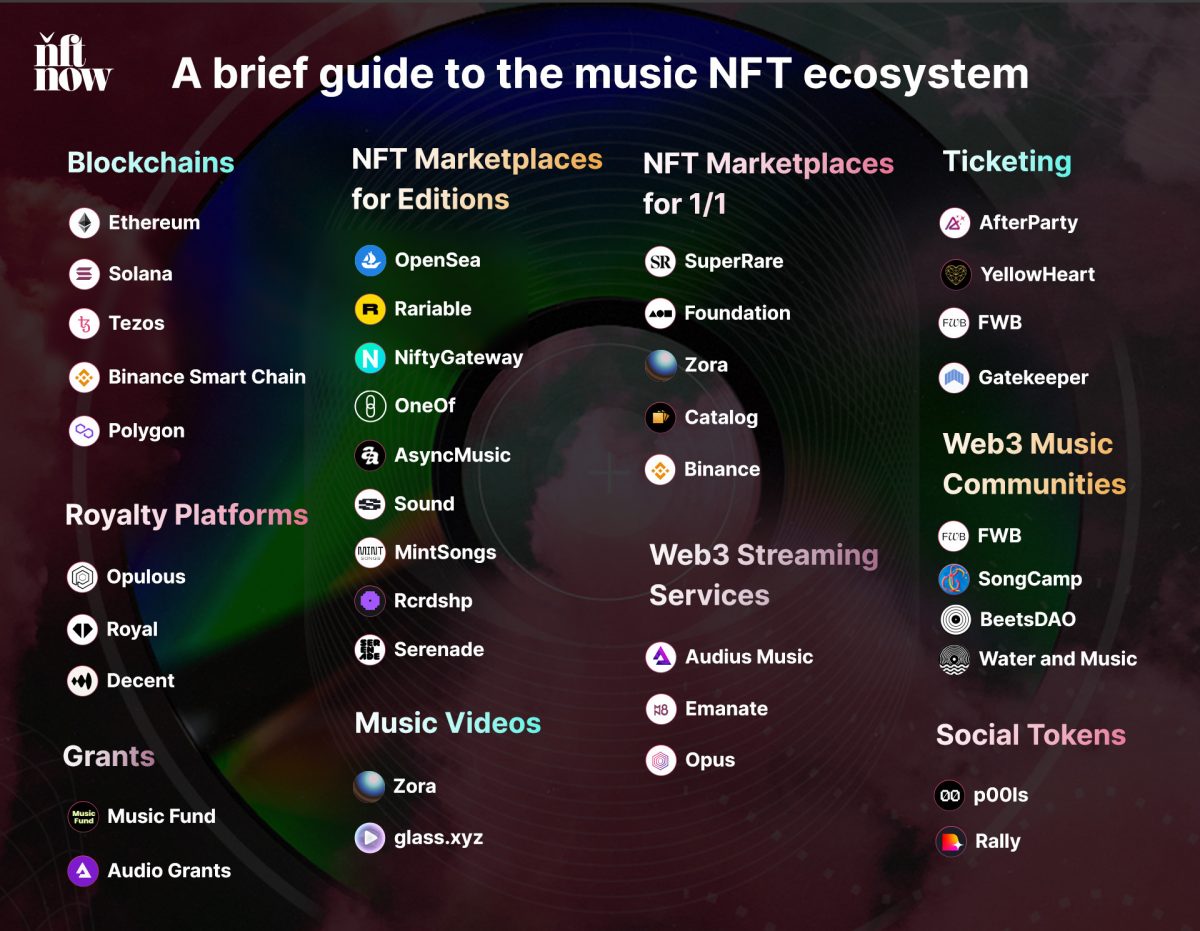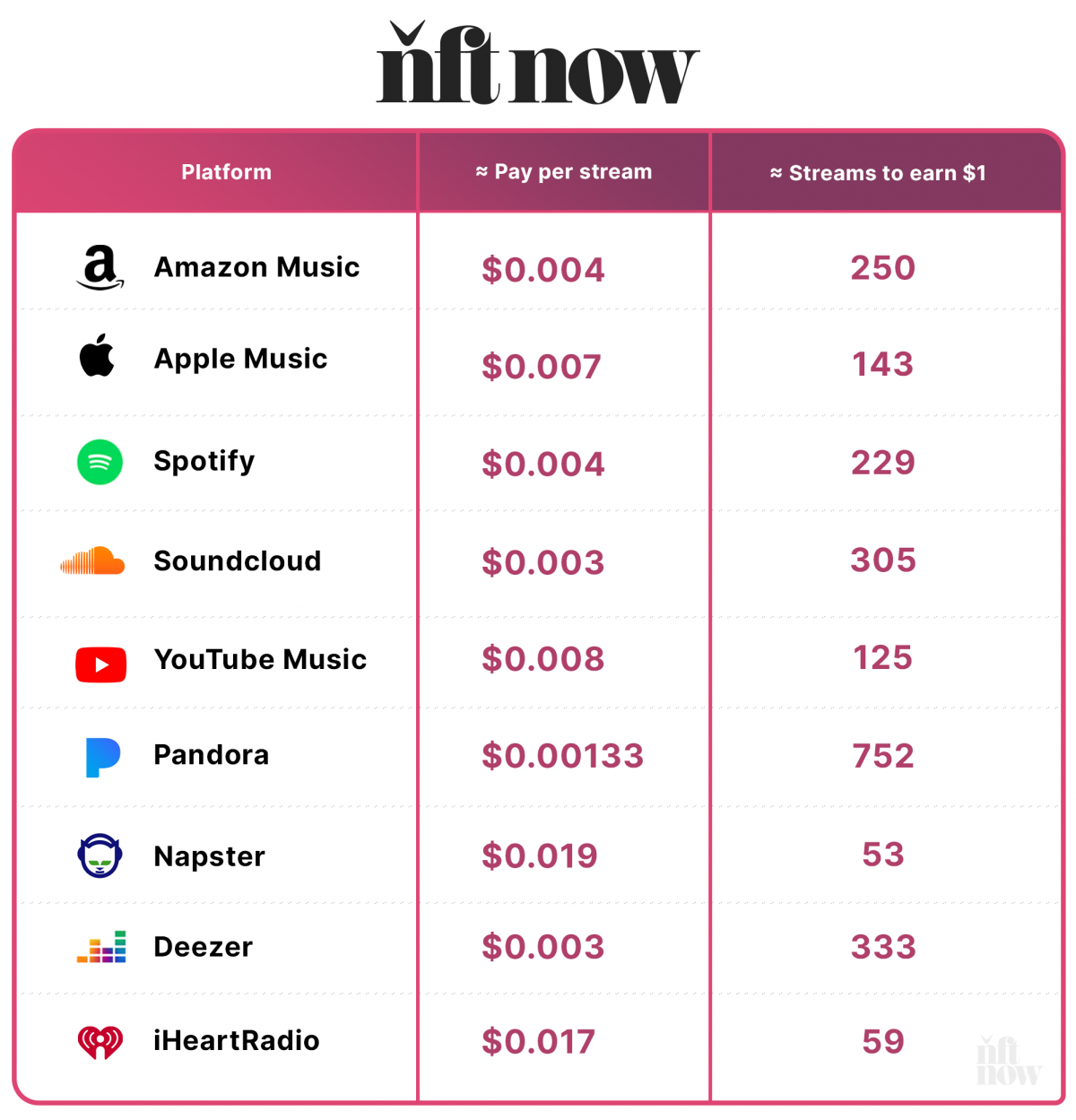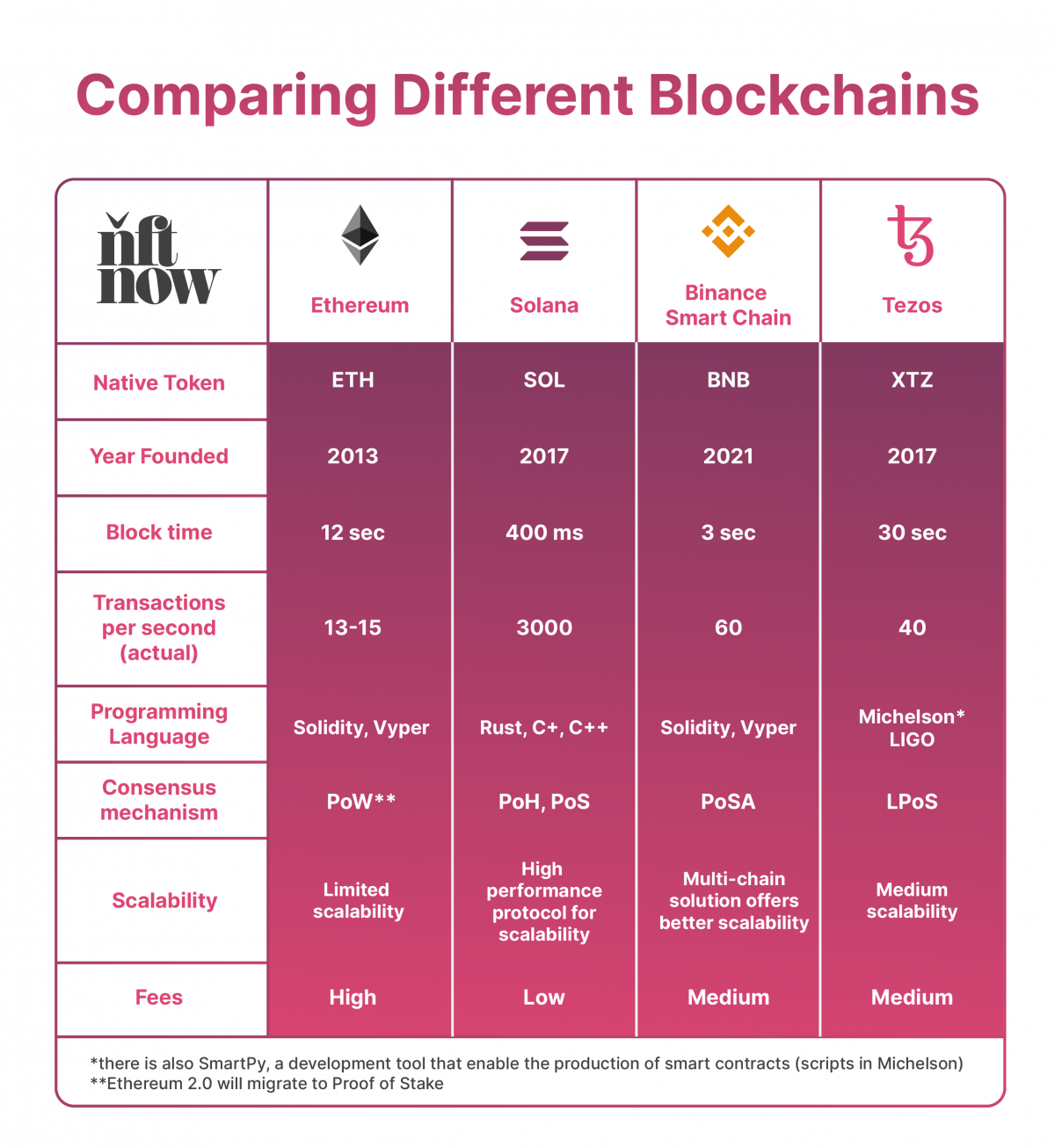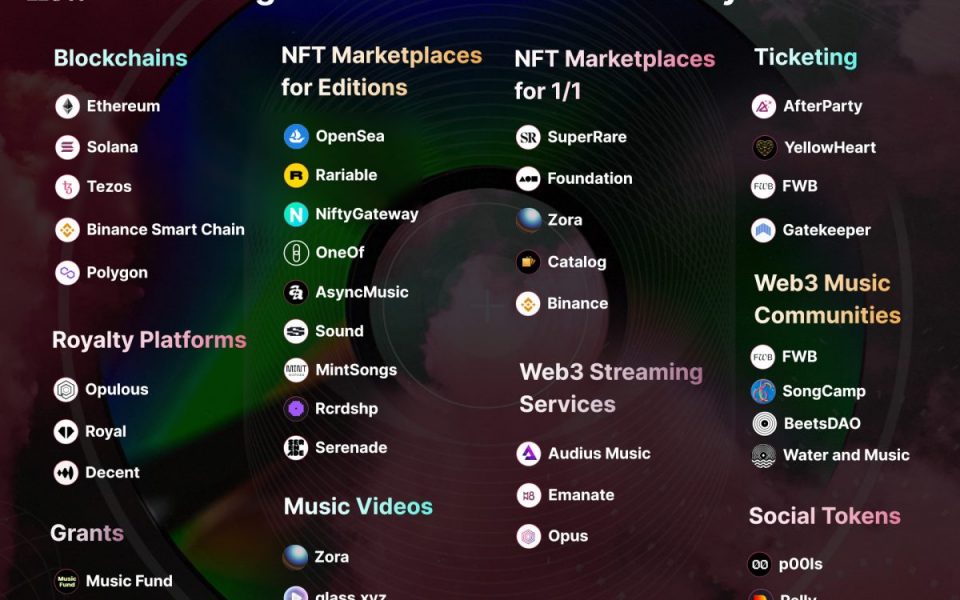The Musician’s Guide to NFTs: Everything You Need to Know
Being a creator in the NFT ecosystem is daunting, especially when you’re just getting started. Although a firm understanding of non-fungible tokens (NFTs) and blockchain technology can certainly help artists succeed, those are tiny pieces of a much larger puzzle. There are also things like pricing, copyright, and community building to consider — and that’s just the beginning of the list.
Sadly, there’s no comprehensive roadmap that can guide musicians through the entire NFT process. And as the ecosystem continues to grow and evolve, things are only getting worse.
This guide to music NFTs is intended to answer this need. It serves as a kind of roadmap, covering everything musicians need to know to go from the starting point to the finish line. If you’re interested in minting and selling your first music NFTs — or if you’re already in the NFT space and just need to fill in some gaps — this guide is for you. But before we get started, here’s a bit of a crash course. Below, you’ll find a brief overview of the major players and tools that (eventually) you will need to know.
The chart is a fantastic resource for those looking to do a little more exploration in relation to the range of music NFT platforms, services, and communities.

Table of Contents
1. What are music NFTs?
2. The benefits of NFTs for musicians
3. Blockchains for music NFTs
4. How to mint music NFTs
5. How to price your NFTs
6. How to build community around your NFTs
7. Navigating Copyright in NFTs
8. Innovators in music NFTs – examples to follow
What are music NFTs?
An NFT is a unique cryptographic token that’s recorded on the blockchain and can be linked to a specific digital or physical asset. That asset could be a video, image, or any other asset you can think of. In this respect, a music NFT is exactly what it sounds like: An NFT that is linked to a piece of music. Music NFTs can be a single song, an entire album, a music video, or even a generative piece of music i.e. music created using a computer program that algorithmically introduces random patterns, colors, sounds, or shapes into the piece.
Of course, music NFTs could also be linked to things that are related to music, like concert tickets or album covers. But we don’t need to be terribly nitpicky with our definitions. The important thing to note is that music NFTs are linked to digital assets that fall under the “music” category.
Music NFTs can be minted as either a 1/1 or an edition.
1/1 means that the NFT has been issued as a single, unique item. An open edition is an NFT in which an unlimited number of editions can be minted. A limited edition is restricted to a predefined number of editions. Some artists have chosen to mint each track on an album as a 1/1 and auction them individually. Others have minted tracks as limited or open editions. There are benefits and drawbacks to each kind of release.
A 1/1 increases the scarcity of the NFT. As a result, this may increase its value. Editions have less scarcity, but they are generally better when it comes to community building and increasing fan loyalty. For example, if you want NFT holders to have access to exclusive offerings in the future, like ticket presales, an edition may be the better option.
Benefits of NFTs for musicians
Many musicians say the music industry is broken. Although the rise of streaming platforms has created a kind of golden age for fans by giving them easy access to virtually any song, it hasn’t been so kind to artists. The music industry’s current business models seem to reward big labels and platforms, often at the expense of the indie creators that are the lifeblood of the industry.
In fact, artists typically only make $0.003 to $0.005 per stream. What does this mean when it comes to total earnings? Let’s turn to Spotify for the answer. It is a $43 billion company, but they only have around 7,500 artists that earn $100,000 or more per year. These figures considered, it seems that streaming benefits the consumer and the provider much more than it does the artist.

With NFTs, artists have a new economic model they can use to profit off of their unique intellectual property. And they can do so without needing a third-party intermediary. Instead of relying on a label or streaming service to get a song circulating — both of which take a cut — artists can mint their own music to a blockchain and sell their NFT independently.
Additionally, thanks to mechanisms built into the blockchain, musicians who create NFTs can also earn royalties from secondary sales. This mitigates problems associated with musicians not making money in relation to both the sale of their work and earning excessively low rates from centralized streaming services. Simply put, many individuals buy music NFTs because it’s a way of empowering and financially supporting the creators that they love.
FURTHER READING: Should You Buy an NFT? Should Anyone?
Blockchains for music NFTs
There are several things to consider when choosing what blockchain to mint on. Some of the most important points are: network size, creator costs, consumer spending habits, security, and community input. Here’s a high-level summary of blockchains for NFTs.
Ethereum: The most popular blockchain for NFTs is Ethereum. It houses some of the most popular marketplaces, NFT projects (CryptoPunks and the Bored Ape Yacht Club), and NFT artists (Pak and Beeple). It is the most expensive option. However, thanks to its popularity, security, decentralization, and ease of use, you should consider this blockchain first when deciding where to mint.
Solana: Solana is one of the fastest programmable blockchains in the crypto space. Its unique combination of proof-of-history (PoH) and proof-of-stake (PoS) consensus mechanisms lead to substantially reduced validation times and fees. In fact, its transaction fees are about as low as they can get. However, Solana isn’t as widely used as Ethereum.
Binance Smart Chain (BSC): If you’re looking for the sweet spot when it comes to fees and performance, BSC is another good option. The problem is that the high-speed transactions and the low fees come at the cost of decentralization. BSC is the most centralized of the options listed here. So if decentralization is important to you, you’ll want to look elsewhere.
Tezos: If you’re looking for a greener alternative, definitely consider the Tezos blockchain. Tezos rose to popularity towards the beginning of 2021. The blockchain uses about two million times less energy than Ethereum. Additionally, it has lower fees than Ethereum (but does cost more than Solana).

How to mint music NFTs
New NFT marketplaces and Web3 streaming services are cropping up nearly every month. So musicians have quite a few options when it comes to minting a piece of music and getting it heard. There are two ways to mint your music NFTs. You can use a marketplace or mint yourself.
No matter which option you choose, you’re going to need a smart contract. Here’s a breakdown of the difference between the two.
NFT marketplaces: Marketplaces let you mint NFTs on their smart contract. As such, they help by taking on the responsibility of minting. Additionally, most platforms already have a lot of users, which means you can get a head start on community building by appealing to an already established base of enthusiasts. One thing to note though: if you use a marketplace, you won’t have complete ownership or control of your collection or storefront.
Making your own smart contract: When provenance comes into play, having your own contract can be invaluable. Countless artists have opted to mint their own NFTs on their own contracts, effectively controlling the entirety of their NFT creation process. It is a more laborious and time-intensive process, but creating a smart contract is easier than ever with services like Manifold.
For beginners, working with a marketplace is likely best. You may not have all the freedom you desire, but it’s a good first step as you become more familiar with the NFT music ecosystem. And because they offer an all-in-one solution, marketplaces also let you get started faster
Choosing an NFT marketplace
General NFT marketplaces
One thing to consider when choosing a marketplace is whether or not you intend to mint one NFT at a time and place it up for auction or mint a collection or batch of NFTs that are each individually priced. For the latter, consider a few of the world’s largest NFT marketplaces, OpenSea, LooksRare, and Rarible. OpenSea is the most popular NFT marketplace, with over 1 million active user wallets on the platform. LooksRare and Rarible are two of the most formidable OpenSea competitors. If you intend to mint 1/1 NFT songs, on the other hand, platforms like SuperRare, Foundation, and Zora are your best bet (although both SupeRare and Foundation require an invitation in order to mint).
And do be prepared, minting comes with an initial cost. Most of the time, you’ll only need to pay a gas fee (transaction fee) to mint, but sometimes marketplaces will tack on extra costs. And if the costs aren’t apparent initially, you may still be paying fees down the line.
Similarly, make sure you do your due diligence when researching royalty splits. You are not guaranteed to have cross-platform royalties when you mint on a platform like OpenSea or Rarible. Though there are smart-contract and minting tools like CXIP that help tackle this problem and 0xSplits that help with automated royalty splits to ensure you receive secondary sales royalties no matter where your NFTs are resold.
Music-specific NFT marketplaces
Catalog is a mix between a streaming service and an NFT marketplace. On Catalog, you can add a record to Catalog’s open music library, set a “buy it now” price, list it in a reserve auction, or accept an offer made by a collector. Although the platform is exclusively a 1/1 marketplace (no edition pieces), artists receive 100% of their initial sales and also earn from resales.
Sound.xyz is a service that combines streaming with minting. On Sound, artists can launch a listening party for new song releases with a series of open or limited edition NFTs. Artists get to keep 100% of the proceeds generated by the sale. This platform also isn’t limited to single tracks and has even hosted mixes like that of Soulection+ that featured 18 different artists that were paid via automated splits.
Async Music is the music-focused arm of prominent NFT platform Async Art. On Async Music, each track (guitar, piano, vocals, percussion) is uploaded separately and with numerous different versions. This allows artists to mint music in a dynamic way — with layers that come together to form one master track.
Mint Songs is one of the only dedicated music NFT platforms that isn’t closed or invite-only. With the core mission to help artists build a sustainable and livable income from creating music, Mint Songs offers a variety of tools as well as $0 minting fees to help artists turn their music into NFTs. They also run on Polygon which makes the platform very accessible with the absence of high transaction fees.
Royal is 3LAU’s new music NFT marketplace that gives NFT owners the rights to songs sold on the platform. This means that those who collect a Royal NFT will be able to receive a portion of royalties generated by that song across traditional streaming platforms (Spotify, Apple, etc.). Although users can purchase NFTs using credit cards (a unique feature by any standards), the platform is currently highly curated, with 3LAU and his team hand-picking each artist and song that is minted on the site.
OneOf is hosted on the Tezos blockchain. The platform is currently highly curated and doesn’t allow for independent minting, only collecting, but it is a good place to list your work. Objkt has become both the defacto marketplace to trade NFTs on the Tezos blockchain and a great place to mint music NFTs. Kalamint is another good marketplace that’s worth a look.
How to price an NFT
If you’re minting NFTs via a platform, you’ll more than likely receive input on pricing. If you’re minting NFTs on your own, it can be difficult to put a value on your work, especially when that value is communicated in fractions of a cryptocurrency.
This is where a little bit of research can really come in handy. No one can tell you exactly what your NFT is worth or what people will be willing to pay. However, there are several artists you can look to for a general idea on how to price your NFT. Prices change month to month, so you should wait to research until you are nearing launch time. Hop over to any of the platforms mentioned in the previous section to see what collections are selling for. You can even give OpenSea’s music section a once-over to see what’s trending and what prices are being realized.
Most importantly, be flexible. Everyone wants to sell a single NFT for 1 ETH right off the bat. However, the reality is that even established artists sometimes struggle to find collectors. It’s fine to put a hopeful price tag on your NFTs, but if that price doesn’t work out, lowering it a bit isn’t going to hurt your reputation.
In fact, if you’re just starting out, it might even be to your benefit to price low and mint a very limited supply of NFTs. A low price (around 0.05 to 0.1 ETH) could help you optimize for turning existing fans into collectors without deterring them through a high sticker price. Creating scarcity at an affordable entry price will ultimately make your early holders proud to support you, and create more demand for future drops.
How to build community around your NFTs
Marketing and selling NFTs go hand in hand with community building. And remember, even once you’ve built a community and achieved a certain level of success, you need to keep building your community. You never finish. Once you get people in the door, you need to continually remind them of why they should stay. This means constantly communicating your value.
Having your own Discord or Twitter group is a great way to start getting your fans gathered in one place. However, there are also plenty of established spaces where you can get your music heard and start making a name for yourself in the NFT community.
Music NFT Platforms
Most of the NFT platforms listed in the previous section have established thriving communities of their own. After you get your name down via a platforms submission form, join their discord and introduce yourself. Many of the artists that drop on these platforms also engage in their communities. There is a lot to be learned by engaging with the folks actively building tools for musicians to succeed in NFTs,
Friends With Benefits
Friends With Benefits (FWB) is a group of creators and thought leaders using web3 tools to build community and foster creative agency. The group lives mostly on Discord and Twitter and is centered around the $FWB token. This group isn’t accessible to anyone though. To join this group, you’ll need to purchase a specific amount of $FWB. But once inside, you’ll be able to access FWB’s wide variety of online and in-person events, workshops, and more all focussing around web3 music and culture.
SongCamp
SongCamp is a web3 music community and NFT experiment. The group hosts monthlong camps that are basically half songwriting and half web3 hackathon. These camps bring together new artists, songwriters, producers, and hackers from all over the world to collaborate on music, visual art, and an NFT rollout at the finish. SongCamp has been operating for nearly a year and has become a sort of melting pot for all things web3 and NFT music. This is a great place to start networking and learning about what other artists are doing in the NFT space.
Twitter Spaces
Over the past year, Twitter Spaces has become a sort of de facto town hall for the NFT community. Numerous NFT influencers, artists, and builders host regular Twitter Spaces to talk about what’s going on in the NFT ecosystem and highlight new and interesting artists and projects. There are many, like nft now’s “The Green Room,” that are geared specifically towards the intersection of music, web3, and NFTs. You’ll definitely want to spend some time researching the active individuals and organizations here.
Navigating Copyright in NFTs
Copyright is a hard subject to traverse in any creative field, especially one as new and dense as NFTs. Some publications have offered up broad overviews of the implications of copyright in NFTs. However, everything is very new, so there’s not a lot of judicial guidance for courts.
But there are some important things that we do know, and which you’ll need to understand to protect yourself.
Who owns an NFT?
The ownership history of an NFT is recorded on the blockchain. This history can be accessed via a block explorer (like Etherscan). Through blockchain records, we are able to tell who created an NFT, when and where the NFT has been since, and usually how much it has been sold for throughout its history.
When it comes to NFTs, this ledger of transactions is how you prove an NFT is yours. Anyone can find the address that you minted an NFT from and, in theory, be able to reference it against the info you provide on your socials and various other NFT accounts.
Just because somebody owns one of your NFTs though, doesn’t imply they have any commercial ownership of your song (masters, publishing, mechanical, etc.). This is of course unless this is an explicit part of your drop. If not, you retain full ownership of the song.
What to do if your NFTs are stolen
Since the beginning of the internet, bad actors have endeavored to profit off of artists’ images, music, and narratives. These thieves will blatantly post content they don’t actually own on their websites, profiles, blogs, etc. in an attempt to attract viewers and obtain ad revenue — and this is, of course, now happening with NFTs.
Artists’ content is protected by international copyright laws, meaning that they have legal recourse when their work is posted by people who don’t have rights to it. This is the exact reason that the Digital Millennium Copyright Act (DMCA) was passed in 1998, to protect digital content.
By filing takedown requests, artists can get their works removed from a website, social channel, or app. This is also true of NFT marketplaces. But that only assumes that an artist has come across the counterfeit work themself, as it isn’t uncommon for thieves to steal and resell art without the original creator ever knowing about it.
Another major problem with filing a takedown notice is seeking out the correct recipient of the notice. It’s not always clear what person — or organization — owns a particular site or marketplace. File with the wrong person or place, and the fraudulent content will stay up.
In addition, artists will need to file individual takedown notices each and every place their work is posted. It’s simple if someone rips off a single NFT, but not so much when multiple storefronts or collections are created using stolen content.
However, DMCA takedowns continue to be one of the best ways to help prevent stolen NFTs and art from being resold.
Innovators in music NFTs – examples to follow
Of course, the graphic shared at the beginning of this article gives a broad and comprehensive overview of the many unique artists, communities, platforms, and more that make up the NFT ecosystem. But when it comes to artists themselves, there are a good few who have truly grinded to carve out a niche for themselves in the NFT space.
These are the people to keep an eye on. Because every NFT leaves a footprint on the blockchain, you can even go back and see where some artists got their start and look at the evolution of their pieces and sale prices over time.
Latashá
Latashá is an artist who is blazing a trail in the NFT space. She is also doing things differently by making big sales and uplifting the music NFT community all in one. As an independent creative and Head of Community Programming at Zora, Latashá is not only helping define what it means to be a music artist in web3, but also pioneering new ways that emerging artists can retain ownership of their intellectual property.
Ibn Inglor
Ibn Inglor is a frontrunner in the new web3 music business model. Similar to what superstar 3LAU is doing with Royal, Inglor recruited his fanbase and his community to help him crowdfund his music projects. In return, his community gets to share in the wealth by way of royalty splits. With ‘DANGER ZONE‘ Inglor raised $92,000 through his $DANGER token sale from buyers who can now participate in a share of up to 40% of the mechanical royalties generated by the release. Inglor described the independent model as “a way to keep control of the music within the community and myself.”
Heno
Heno is a first-generation Ethiopian/Eritrean-American artist and musician whose work focuses on the Black consciousness. Heno channeled his toxic experiences with law enforcement into a fourteen-track album titled ‘I’m Tired Of Being Hypersurveilled‘ with an ongoing 20 ETH crowdfund. To get a better sense of how the broader music x NFT ecosystem has evolved over the last year, read our Top 21 Music NFT Moments of 2021.
Daniel Allan
Daniel Allan has become one of the most prominent names in the music NFT market. First turning heads with the completion of a nearly 50 ETH ($140,000) crowd-fund for his EP, “Overstimulated,” the producer/artist and general Web3 enthusiast has carved out a unique niche for himself within the NFT ecosystem through selling a laundry list of impressive releases via curated music NFT platforms like Catalog and Sound. His endeavors thus far have undoubtedly inspired others to become involved in the music side of NFTs and have even led to him being featured in TIME Magazine.
The fade-out
Music NFTs are still widely under development. In the grand scheme of the NFT market, musicians and artists are still having to put their heads down and work to achieve success in the NFT space, but it seems to be getting easier with every passing month.
As more established artists make their way into Web3 and NFTs, we will undoubtedly see growth on an exponential scale within the music NFT ecosystem. Yet, as opposed to the legacy music industry that fills small artists with disdain, there truly seems to be a middle class in music NFTs.
There is a massive opportunity to bring power back to the creators of the music we love. Through NFTs, we’re able to create a more equitable model for prosperity. But it isn’t going to happen on its own. It’s up to the creators of culture who are willing to stick their necks out and try something new. And after reading this, hopefully, that means you.
The post The Musician’s Guide to NFTs: Everything You Need to Know appeared first on nft now.

